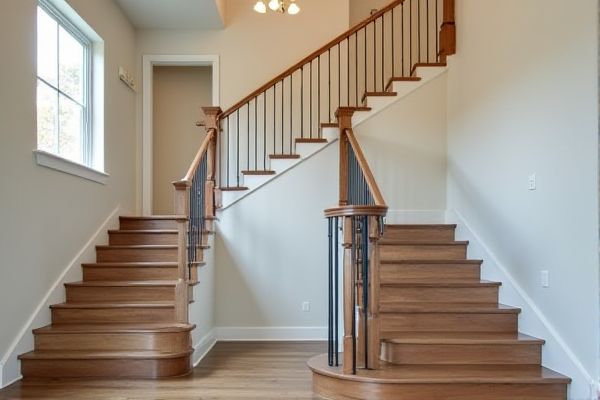
Code-compliant stairs adhere strictly to local building regulations ensuring safety, uniformity, and legal approval, while custom stairs offer personalized designs tailored to your aesthetic preferences and spatial requirements but might require additional approvals. Discover the key differences and make an informed decision by reading the rest of the article.
Table of Comparison
| Feature | Code-Compliant Stairs | Custom Stairs |
|---|---|---|
| Design | Standardized dimensions and layout | Tailored design to fit specific needs and aesthetics |
| Safety | Meets local building codes and safety regulations | Can exceed code requirements or incorporate unique safety features |
| Cost | Generally lower cost due to standardization | Higher cost from customization and specialized materials |
| Materials | Common, readily available materials | Wide range of materials including premium or unusual options |
| Installation Time | Faster installation with prefabricated components | Longer installation due to custom fabrication |
| Maintenance | Standard maintenance based on common materials | Maintenance varies based on unique materials and design |
| Compliance | Fully compliant with building codes and regulations | May require additional approvals or inspections |
Introduction to Code-Compliant Stairs and Custom Stairs
Code-compliant stairs adhere strictly to local building codes and safety regulations, ensuring standardized dimensions, riser heights, and tread depths for optimal safety and accessibility. Custom stairs offer personalized design options, allowing for unique materials, shapes, and styles tailored to your home's aesthetic and spatial requirements. Choosing between code-compliant and custom stairs involves balancing regulatory safety standards with creative design flexibility.
Building Codes: What Are Code-Compliant Stairs?
Building codes for code-compliant stairs establish strict guidelines on dimensions such as riser height, tread depth, handrail placement, and load-bearing capacity to ensure safety and accessibility. Custom stairs may deviate from these standards to achieve unique aesthetics or fit unusual spaces but risk non-compliance and potential safety hazards without proper review. Ensuring your stairs meet local building codes is critical for legal approval and occupant safety in residential or commercial properties.
Characteristics of Custom Stairs
Custom stairs offer tailored designs that accommodate unique architectural styles and specific spatial requirements, unlike standard code-compliant stairs which adhere strictly to regulatory dimensions and materials. These stairs often feature specialized materials, unique tread and riser configurations, and artistic details that enhance aesthetic appeal while meeting safety standards. Custom stairs provide greater flexibility in size, shape, and finish, allowing for personalized functionality and distinctive visual impact in both residential and commercial spaces.
Key Differences Between Code-Compliant and Custom Stairs
Code-compliant stairs strictly follow local building regulations, ensuring safety standards like tread depth, riser height, and handrail placement are met to prevent accidents. Custom stairs offer flexibility in design, allowing you to incorporate unique materials, shapes, and dimensions that enhance aesthetic appeal but may require additional approvals. Understanding these key differences helps you balance safety, functionality, and style in your staircase project.
Safety Standards: Why Compliance Matters
Code-compliant stairs adhere strictly to safety standards set by regulatory bodies, ensuring proper dimensions, handrail placement, and slip-resistant materials that minimize accident risks. Custom stairs may offer unique designs tailored to Your space but risk non-compliance if not carefully engineered to meet local building codes, potentially compromising safety. Prioritizing compliance guarantees structural integrity and protects occupants from falls and injuries, making safety the critical factor in stair design.
Design Flexibility in Custom Stairs
Custom stairs offer unparalleled design flexibility, allowing you to tailor each element to your specific aesthetic and spatial needs beyond the limitations of code-compliant stairs. Unlike standard code-compliant stairs that must adhere to strict regulations for rise, run, and handrail placement, custom stairs can incorporate unique materials, shapes, and sizes to create a striking architectural feature. This flexibility enables the seamless integration of your personal style while ensuring safety and functionality.
Cost Comparison: Code-Compliant vs Custom Stairs
Code-compliant stairs typically cost less due to standardized designs, materials, and labor efficiency, making them budget-friendly for most construction projects. Custom stairs, however, often require specialized craftsmanship, unique materials, and additional design time, driving costs significantly higher. Understanding your budget and aesthetic goals will help determine whether the affordability of code-compliant stairs or the personalized elegance of custom stairs is the right investment for your space.
Accessibility and Usability Considerations
Code-compliant stairs adhere to strict regulations ensuring consistent riser height, tread depth, and handrail placement, promoting safety and accessibility for all users, including those with mobility impairments. Custom stairs offer tailored designs that can accommodate specific spatial constraints and aesthetic preferences but may require careful engineering to meet or exceed accessibility standards. Prioritizing usability involves balancing regulatory compliance with ergonomic features, such as wider treads and low-rise steps, to enhance comfort and functionality for diverse users.
Permits and Legal Requirements for Stair Construction
Code-compliant stairs adhere strictly to local building codes and regulations, ensuring that permits are obtained and legal requirements are met to guarantee safety and accessibility. Custom stairs may require additional permits or inspections due to design variations, making it essential to consult local authorities during the planning stage. Failure to secure proper permits or meet legal standards can result in costly fines, mandatory modifications, or safety hazards.
Choosing the Right Stair Solution for Your Project
Code-compliant stairs adhere strictly to local building regulations ensuring safety, accessibility, and legal approval, making them ideal for standard residential or commercial projects. Custom stairs offer flexibility in design, materials, and dimensions, perfect for unique architectural styles or when specific aesthetic and functional requirements must be met. Evaluating project needs, budget, and compliance requirements helps determine whether the reliable standards of code-compliant stairs or the tailored appeal of custom stairs is the optimal choice.
 homyna.com
homyna.com